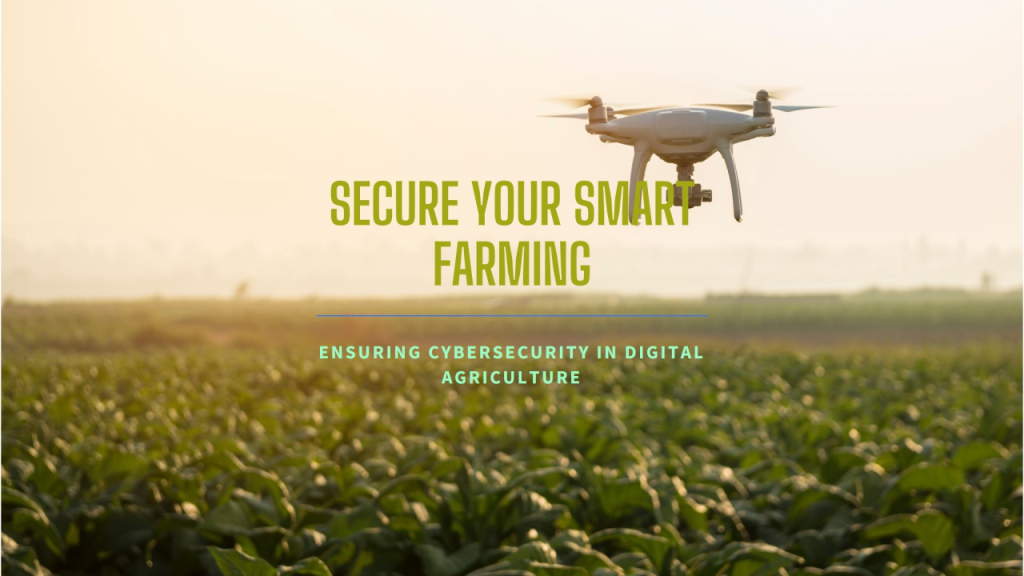Imagine waking up one morning to find your entire smart farm at a standstill. Your irrigation system is offline, your data is inaccessible, and your crops are at risk.
Cyber threats are not just something that happens in movies or big corporations; they can hit close to home, right in the heart of your farm. In a world where technology is the backbone of modern agriculture, protecting your farm from cyberattacks is as crucial as safeguarding it against pests or harsh weather.
You might think, “Cyber threats? Is that something I really need to worry about? ” The answer is a resounding yes. Cybercriminals are increasingly targeting smart farms, knowing that a single breach can disrupt operations and lead to significant losses. But don’t worry—securing your smart farm doesn’t have to be complicated or expensive. By understanding the risks and implementing a few strategic measures, you can protect your investment and ensure your farm runs smoothly. You’ll discover practical steps you can take to safeguard your smart farm from cyber threats. From strengthening your network defenses to training your team, we’ll guide you through the essential actions that will give you peace of mind. Ready to fortify your farm’s digital walls? Let’s dive in and explore how you can keep your smart farm secure.

Assessing Vulnerabilities
Assessing vulnerabilities protects smart farms from cyber threats. Identify weak points in your network and devices. Regular updates and secure passwords enhance security, safeguarding your farm’s operations and data.
When it comes to protecting your smart farm from cyber threats, assessing vulnerabilities is a crucial step. You need to understand where your farm might be at risk. This helps in fortifying weak points before they can be exploited by cybercriminals.Identifying Critical Assets
Start by listing all your digital assets. Think about everything from IoT devices to software applications. Each piece of technology could be a potential entry point for cyber threats. Ask yourself: Which assets are most crucial to your farm’s operations? Prioritize these for security measures. Consider their role in daily activities and the impact if they were compromised.Evaluating Network Security
Check the security of your network. Is your Wi-Fi password strong and unique? A simple password can be an open door for hackers. Review your firewall settings. Ensure they are properly configured to block unauthorized access. Regular updates can enhance their effectiveness against new threats.Analyzing Software Vulnerabilities
Keep your software updated. Outdated software can have vulnerabilities that hackers exploit. Regular updates patch these security holes. Pay attention to third-party applications. They might not have the same robust security standards. Assess their necessity and security before use.Understanding User Access Controls
Who has access to your systems? Limiting access can significantly reduce risks. Only grant permissions to those who absolutely need them. Set up strong authentication methods. Consider two-factor authentication for an added layer of security. This makes unauthorized access more difficult.Reviewing Data Protection Measures
Data is a valuable asset. Assess how your data is stored and protected. Are you using encryption to safeguard sensitive information? Implement regular backups. This ensures data recovery in case of a breach. Having a backup plan can save you from significant losses. As you assess vulnerabilities, remember that no system is immune to cyber threats. The goal is to make your smart farm a less attractive target. Are you ready to take the necessary steps to safeguard your farm?
Implementing Strong Authentication
Smart farming is changing agriculture. It offers new ways to manage crops. But with technology comes risk. Cyber threats can target your smart farm. Keeping your farm safe is crucial. Implementing strong authentication is key. It protects sensitive data and operations. Let’s explore how to do this effectively.
Understanding Two-factor Authentication
Two-factor authentication adds an extra security layer. It requires two proofs of identity. First, a password. Second, a unique code sent to your device. This makes hacking difficult. Hackers need more than just your password. It’s a simple yet powerful tool.
Biometric Security Features
Biometric security uses physical traits. Fingerprints or facial recognition are common examples. It’s hard to fake these traits. Biometric security offers strong protection. It ensures only authorized users access systems. It’s efficient and reliable.
Using Complex Passwords
Complex passwords enhance security. Avoid simple words or numbers. Combine letters, symbols, and numbers. Make passwords long and unique. Change them regularly. This prevents unauthorized access. It’s a basic but essential practice.
Regular Security Updates
Security updates fix vulnerabilities. They keep systems secure from new threats. Regular updates are vital. They protect your farm from cyber attacks. Always install the latest updates. Stay informed about new security patches.
Training For Farm Staff
Training staff is crucial for security. Teach them about cyber threats. Show them how to use security tools. Awareness reduces human errors. It strengthens your farm’s defenses. Invest in regular training sessions.
Regular Software Updates
Keeping your smart farm safe from cyber threats involves regular software updates. These updates fix security gaps, making your systems more secure. Updated software also improves performance, protecting sensitive data.
Ensuring your smart farm is shielded from cyber threats is crucial for maintaining its efficiency and productivity. One of the simplest yet most effective strategies is regular software updates. Keeping your systems up to date not only provides new features but also enhances security measures. Ignoring updates can leave your farm exposed to vulnerabilities and risks. Let’s dive into why this is so important and how you can manage it effectively.Stay Ahead Of Cyber Threats
Every software update is a step forward in protecting your systems. Cybercriminals are continuously evolving their tactics, and outdated software can be an open door for them. Updating your software regularly closes security gaps, reducing the risk of unauthorized access. Think about the last time you updated your phone’s apps. Those updates often come with security patches that protect your personal data. Your smart farm deserves the same attention to maintain its integrity.Automate Your Updates
Consider setting your software to update automatically. This ensures you don’t miss critical updates, even during busy seasons. Automatic updates can save you time and keep your systems consistently protected. I once forgot to update the software on a small device in my smart farm. It resulted in a minor breach that cost more time to fix than if I had just set it to update automatically. Automating this process can be a huge relief and ensure peace of mind.Check Compatibility
Before updating, ensure that new software versions are compatible with your existing systems. An update might bring new features or security patches but could also disrupt operations if not compatible. Research and, if needed, consult with your technology provider to avoid any hiccups. Remember how frustrating it is when a phone update makes an app unusable? Imagine that on a larger scale with your farm’s vital systems. Compatibility checks are a small step with significant benefits.Schedule Regular Audits
Regular audits help you keep track of which systems need updates. Create a schedule to review your software and hardware to ensure everything is current. This proactive approach minimizes the risk of overlooking essential updates. Consider making a checklist for your audits. It’s like a health check for your farm’s technology. Are all your devices running the latest software? A simple checklist can help you keep everything in line and secure.Engage With Your Team
Educate your team about the importance of updates. Everyone involved in the farm should understand the role updates play in security. Encourage them to report any notifications about available updates immediately. Have you ever ignored a software update notification, thinking it wasn’t important? Your team might be doing the same. Engaging them ensures that everyone is on the same page about maintaining security. Updating your smart farm’s software is not just a technical task—it’s a critical part of your farm’s security strategy. How do you plan to implement these strategies to keep your farm secure?
Monitoring And Incident Response
Protect your smart farm with effective monitoring and incident response. Quick detection of threats ensures safety. Regular updates and strong passwords help keep hackers at bay.
Monitoring and incident response are essential for keeping your smart farm safe from cyber threats. With the rise of smart farming technologies, there’s an increasing risk of cyber attacks that can disrupt operations or steal sensitive information. To protect your investment and ensure smooth operations, it’s crucial to have a robust monitoring system and a well-prepared incident response plan.Monitoring Systems
Having a reliable monitoring system is like having a security camera for your digital assets. Regularly check your network for any unusual activities or unauthorized access. This can be achieved using software that constantly scans for anomalies in data flow or system behavior. Consider setting up alerts for specific events. If someone tries to access your system from an unfamiliar location, you should know about it immediately. This allows you to act quickly before any damage is done. Keep your software up to date. Cyber threats evolve rapidly, and outdated software can have vulnerabilities. Regular updates ensure your monitoring system is equipped to detect the latest threats.Incident Response Plan
An effective incident response plan is your farm’s emergency protocol for cyber attacks. If a breach occurs, you need a clear, step-by-step plan to minimize damage and restore operations. Start by identifying key personnel. Who will be responsible for managing the response? Ensure they are trained and understand their roles. Document every step of your response plan. From identifying the threat to communicating with stakeholders, clarity is crucial. This documentation should be easily accessible to everyone involved. Practice your plan regularly. Conduct drills to test your response strategy. This will highlight any weaknesses and give your team the confidence to act decisively if a real threat occurs.Continuous Improvement
Cyber threats are always evolving. Is your defense keeping up? Regularly review and update both your monitoring systems and incident response plan. Engage with cybersecurity experts. They can offer insights into the latest threats and provide guidance on improving your defenses. Learn from past incidents. If you’ve faced a cyber threat before, analyze what went well and what didn’t. Use this knowledge to strengthen your systems. By taking these steps, you not only protect your smart farm but also increase its resilience against future threats. What measures are you taking to safeguard your farm’s digital assets?Conclusion
Protecting your smart farm from cyber threats is essential. Simple steps can make a big difference. Regular updates and strong passwords help secure systems. Training staff enhances safety and awareness. Monitoring devices regularly prevents unauthorized access. Choosing trusted vendors ensures reliable security measures.
By following these tips, you can safeguard your farm. Reduce risks and keep operations smooth. Cybersecurity is not just for tech experts. It’s for everyone involved in farming. Stay vigilant and proactive. Your farm’s future depends on it. Safety today leads to success tomorrow.
Keep your smart farm secure and thriving.



